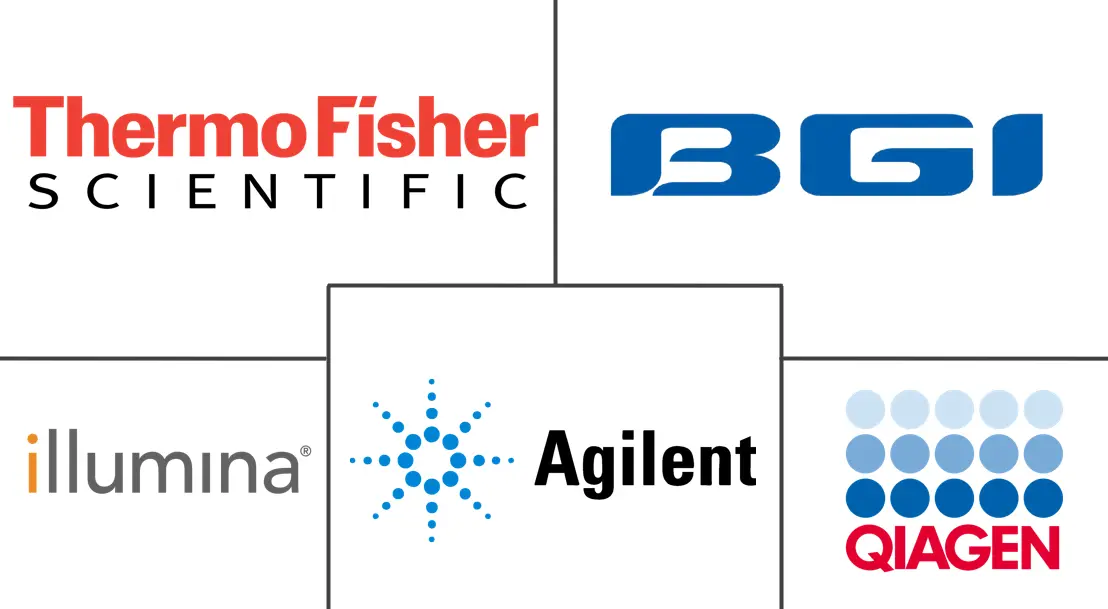Short-Read Sequencing Market Size and Share
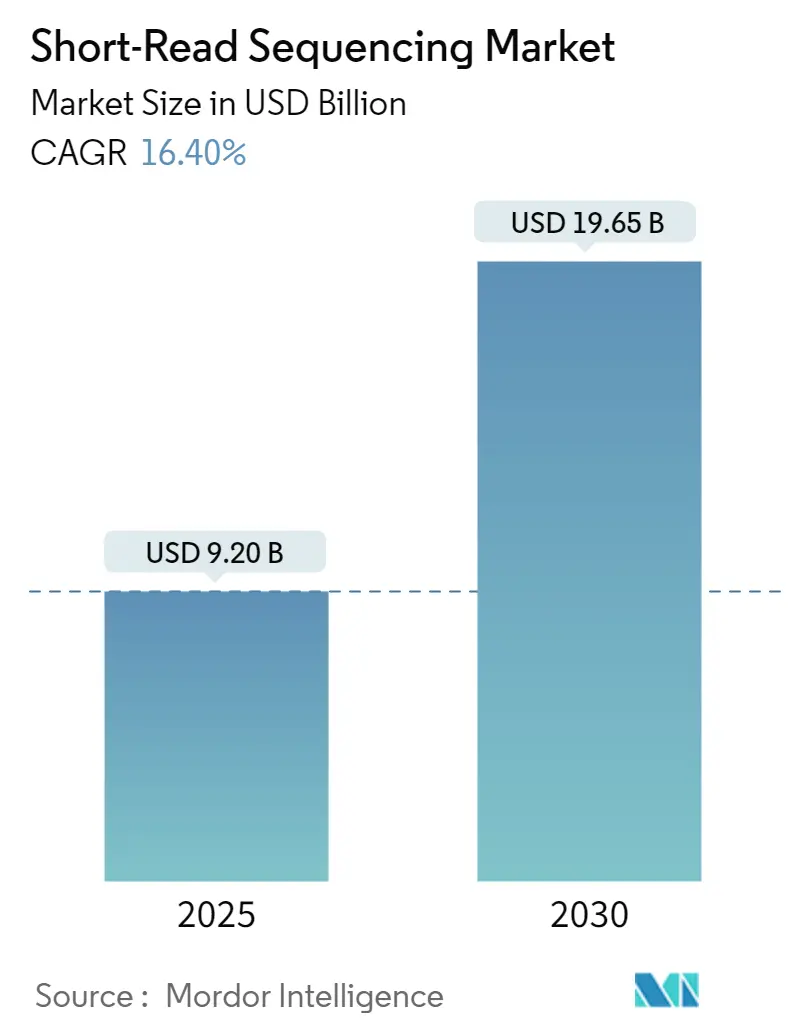
Short-Read Sequencing Market Analysis by Mordor Intelligence
The Short-Read Sequencing Market size is estimated at USD 9.20 billion in 2025, and is expected to reach USD 19.65 billion by 2030, at a CAGR of 16.4% during the forecast period (2025-2030).
The short-read sequencing market is influenced by several factors that impact its growth and adoption in the genomics and life sciences sectors. Some of the major driving factors include rising demand for precision medicine, continuous advancements in genomics research, and cost-effectiveness and efficiency of short-read sequencing technologies.
Continuous advancements in genomics research drive the demand for sequencing technologies to study genetic variations, disease mechanisms, and personalized medicine. For instance, in May 2024, SOPHiA GENETICS, a cloud-native healthcare technology company, partnered with Microsoft and NVIDIA. This collaboration aims to harness their combined technological and genomic expertise. The goal is to introduce a more efficient and scalable solution for whole genome sequencing (WGS) analysis in healthcare institutions. Hence, technological advancements in sequencing help analyze data using short-read sequencing methods, which is expected to boost market growth during the forecast period.
Also, growing company activities such as collaborations, partnerships, and agreements for developing new products are expected to propel the market growth during the forecast period. For instance, in August 2023, PacBio, a leading provider of precise sequencing solutions, agreed to acquire Apton Biosystems Inc. (Apton). Apton, headquartered in the United States, specializes in a cutting-edge short-read sequencer. This approach efficiently tests billions of DNA clusters on a single flow cell. Hence, these strategic activities increase the company’s portfolios and are expected to drive market growth during the forecast period.
Therefore, continuous advancements in genomics research and company activities are expected to increase the demand for short-read sequencing products and services, boosting market growth during the forecast period. However, complexity in sequencing data analysis and interpretation and competition from other sequencing technologies are expected to restrain market growth during the forecast period.
Global Short-Read Sequencing Market Trends and Insights
The Whole Genome Sequencing (WGS) Application Segment is Expected to Have a Significant Share in the Market During the Forecast Period
Whole genome sequencing (WGS) involves determining the complete DNA sequence of an organism’s genome. This includes all its genes (coding regions) and non-coding regions, such as regulatory sequences, intergenic regions, and repetitive elements. WGS, using short-read sequencing technologies, has revolutionized genomics research and clinical diagnostics by providing comprehensive insights into an organism’s entire DNA sequence.
The application of short-read sequencing in whole genome sequencing is propelled by its cost-effectiveness, high throughput, accuracy, versatility, clinical relevance, and continuous advancements in research and technology. In addition, the growing research on WGS and growing funding on genome sequencing is expected to propel the segment growth during the forecast period.
For instance, in January 2024, the UK Biobank made the world's largest whole-genome dataset, covering all 500,000 participants, accessible to approved researchers through its UK Biobank Research Analysis Platform. Similarly, in 2023, the Alliance for Genomic Discovery (AGD) completed whole-genome sequencing of around 86,000 DNA samples, a significant milestone toward their goal of 250,000 samples from VUMC's BioVU biobank. This large whole-genome data set helps global research using short-read sequencing, boosting segment growth during the forecast period.
Hence, the whole genome sequencing segment is expected to witness significant growth in the upcoming years due to the factors above, such as widespread applications and growing research activities.
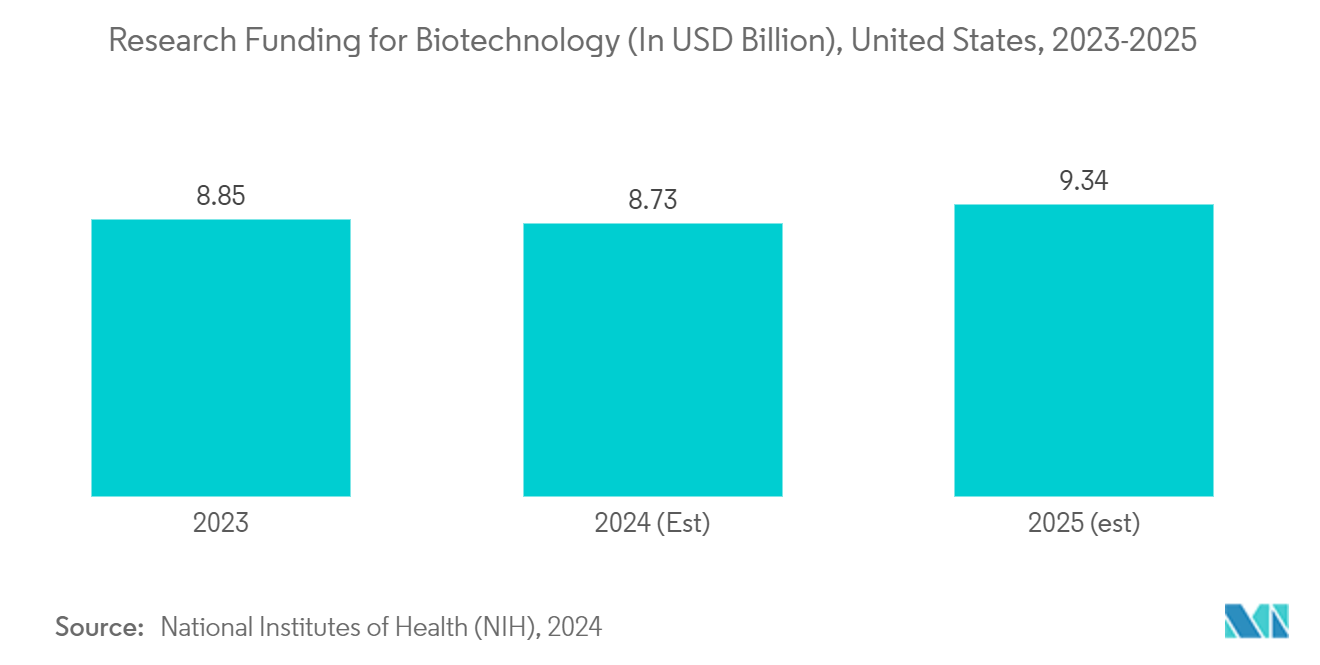
North America is Expected to Hold a Significant Share in the Market During the Forecast Period
North America is expected to hold a significant market share due to growing research funding on genomics. Rapid acceptance and penetration of short-read sequencing for research studies also contributed to the segment's dominance during the study period. In addition, a strong presence of established players offering a wide range of solutions and access to developed healthcare infrastructure is anticipated to drive market growth across the region.
For instance, according to data published by the National Institutes of Health (NIH) in May 2024, research funding for human genome projects was reported to be USD 4,946 million in 2023, and it is estimated to be USD 5,228 million by 2025 in the United States. This shows the growing research funding for genome projects, which is expected to raise the demand for short-read sequencing, thereby boosting the market growth during the forecast period.
Also, establishing new sequencing services with equipment in the region is expected to propel the market growth during the forecast period. For instance, in October 2023, GIFS’ Omics and Precision Agriculture Laboratory (OPAL) in Western Canada offered genomics analysis services using PacBio’s new Revio DNA sequencer. This includes long- and short-read DNA sequencing technology. Hence, the widespread availability of these services in the region is expected to propel the market growth in the coming years.
Therefore, the market in North America is expected to grow due to factors such as research funding and the widespread availability of services.
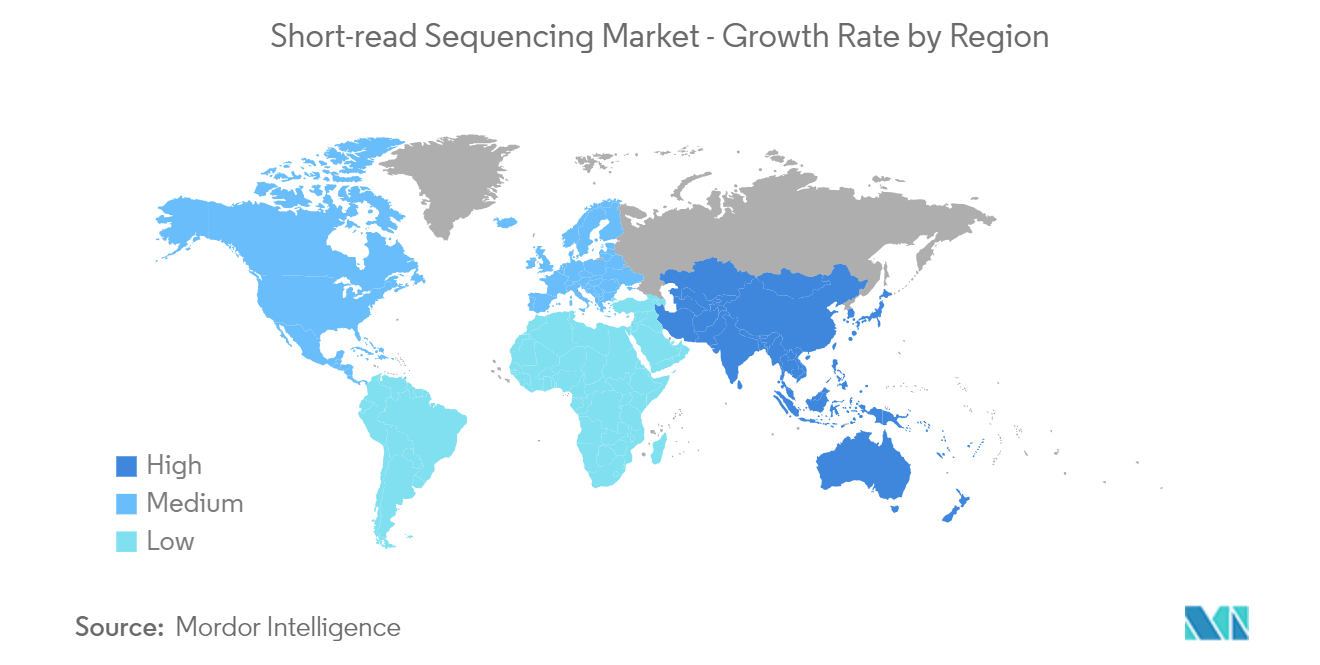
Competitive Landscape
The short-read sequencing market is semi-consolidated due to only major players operating globally and regionally. The competitive landscape includes analyzing international companies with significant market share. Some of the major players in the market include Illumina Inc., Thermo Fisher Scientific Inc., QIAGEN, BGI (Beijing Genomics Institute), and Agilent Technologies.
Short-Read Sequencing Industry Leaders
-
Illumina, Inc.
-
Thermo Fisher Scientific, Inc.
-
QIAGEN
-
BGI (Beijing Genomics Institute)
-
Agilent Technologies
- *Disclaimer: Major Players sorted in no particular order
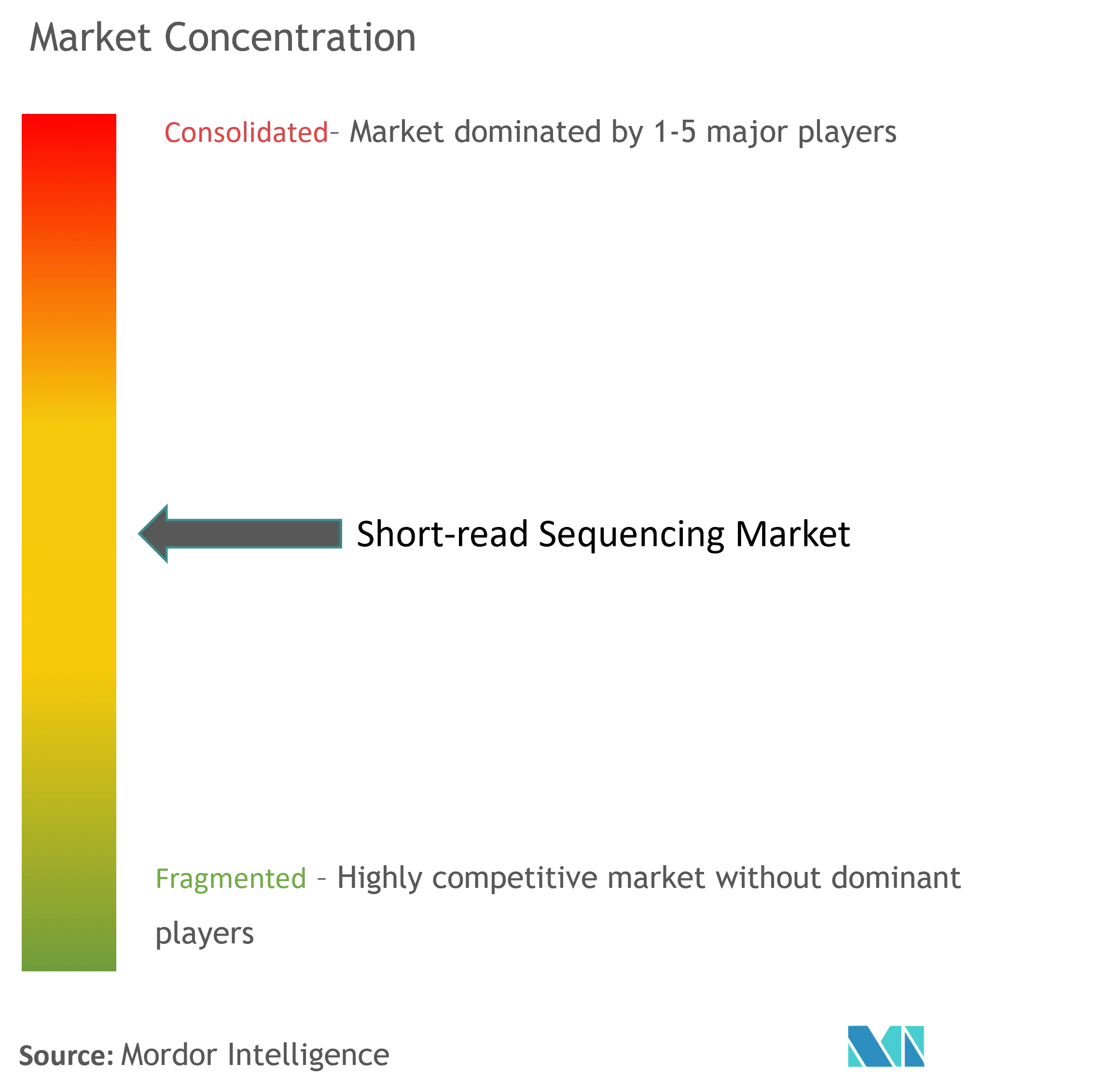
Recent Industry Developments
- December 2023: Firalis Molecular Precision, a contract research organization (CRO), significantly bolstered its genomics capabilities by acquiring the cutting-edge Illumina NovaSeq X Plus Sequencing System. This system offers dual flow cell sequencing, enabling refinement and scaling-up of short-read sequencing technology.
- August 2023: PacBio, a developer of high-quality, highly accurate sequencing solutions, started commercializing the Onso short-read sequencing system in the United States. Its novel sequencing by binding (SBB) chemistry is designed to provide accuracy in a user-friendly and flexible benchtop platform.
Global Short-Read Sequencing Market Report Scope
As per the scope of the report, short-read sequencing refers to a genomic sequencing method that generates relatively short DNA or RNA fragments, typically ranging from 50 to 300 base pairs in length. Due to its cost-effectiveness, high accuracy, and scalability, short-read sequencing is widely used in genomics research, clinical diagnostics, and other fields.
The short-read sequencing market is segmented by products and services, platforms, applications, end users, and geography. By products and services, the market is segmented into instruments, consumables, and services. By platform, the market is segmented into sequencing by synthesis (SBS), sequencing by binding (SBB), and sequencing by ligation (SBL). By application, the market is segmented into whole genome sequencing (WGS), whole exome sequencing (WES), and other applications. The market is segmented by end user into academic and research institutes, pharmaceutical and biotechnology companies, clinical research laboratories, and other end users. The market is segmented by geography into North America, Europe, Asia-Pacific, the Middle East and Africa, and South America. The report also covers the estimated market sizes and trends for 17 countries across the major regions globally. The report offers the value (in USD) for the above segments.
| Instruments |
| Consumables |
| Services |
| Sequencing by Synthesis (SBS) |
| Sequencing by Binding (SBB) |
| Sequencing by Ligation (SBL) |
| Whole Genome Sequencing (WGS) |
| Whole Exome Sequencing (WES) |
| Other Applications |
| Academic and Research Institutes |
| Pharmaceutical and Biotechnology Companies |
| Clinical Research Laboratories |
| Other End Users |
| North America | United States |
| Canada | |
| Mexico | |
| Europe | Germany |
| United Kingdom | |
| France | |
| Italy | |
| Spain | |
| Rest of Europe | |
| Asia-Pacific | China |
| Japan | |
| India | |
| Australia | |
| South Korea | |
| Rest of Asia-Pacific | |
| Middle East and Africa | GCC |
| South Africa | |
| Rest of Middle East and Africa | |
| South America | Brazil |
| Argentina | |
| Rest of South America |
| By Product and Services | Instruments | |
| Consumables | ||
| Services | ||
| By Platform | Sequencing by Synthesis (SBS) | |
| Sequencing by Binding (SBB) | ||
| Sequencing by Ligation (SBL) | ||
| By Application | Whole Genome Sequencing (WGS) | |
| Whole Exome Sequencing (WES) | ||
| Other Applications | ||
| By End User | Academic and Research Institutes | |
| Pharmaceutical and Biotechnology Companies | ||
| Clinical Research Laboratories | ||
| Other End Users | ||
| Geography | North America | United States |
| Canada | ||
| Mexico | ||
| Europe | Germany | |
| United Kingdom | ||
| France | ||
| Italy | ||
| Spain | ||
| Rest of Europe | ||
| Asia-Pacific | China | |
| Japan | ||
| India | ||
| Australia | ||
| South Korea | ||
| Rest of Asia-Pacific | ||
| Middle East and Africa | GCC | |
| South Africa | ||
| Rest of Middle East and Africa | ||
| South America | Brazil | |
| Argentina | ||
| Rest of South America | ||
Key Questions Answered in the Report
How big is the Short-Read Sequencing Market?
The Short-Read Sequencing Market size is expected to reach USD 9.20 billion in 2025 and grow at a CAGR of 16.40% to reach USD 19.65 billion by 2030.
What is the current Short-Read Sequencing Market size?
In 2025, the Short-Read Sequencing Market size is expected to reach USD 9.20 billion.
Who are the key players in Short-Read Sequencing Market?
Illumina, Inc., Thermo Fisher Scientific, Inc., QIAGEN, BGI (Beijing Genomics Institute) and Agilent Technologies are the major companies operating in the Short-Read Sequencing Market.
Which is the fastest growing region in Short-Read Sequencing Market?
Asia Pacific is estimated to grow at the highest CAGR over the forecast period (2025-2030).
Which region has the biggest share in Short-Read Sequencing Market?
In 2025, the North America accounts for the largest market share in Short-Read Sequencing Market.
What years does this Short-Read Sequencing Market cover, and what was the market size in 2024?
In 2024, the Short-Read Sequencing Market size was estimated at USD 7.69 billion. The report covers the Short-Read Sequencing Market historical market size for years: 2019, 2020, 2021, 2022, 2023 and 2024. The report also forecasts the Short-Read Sequencing Market size for years: 2025, 2026, 2027, 2028, 2029 and 2030.
Page last updated on:
Short-Read Sequencing Market Report
Statistics for the 2025 Short-Read Sequencing market share, size and revenue growth rate, created by Mordor Intelligence™ Industry Reports. Short-Read Sequencing analysis includes a market forecast outlook for 2025 to 2030 and historical overview. Get a sample of this industry analysis as a free report PDF download.
